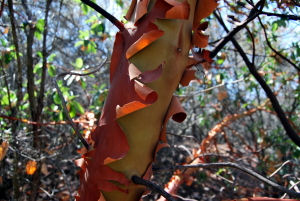The first is that, well, plants will just be different. It's not as if we're going to have barren soil where plants are now. As climate changes and warms, plants will most likely shift to the north. If we're talking an 8.3 degree Celsius shift in the summers, that means a rise of about 15 degrees Fahrenheit during the summer. Desert plants would move into Bakersfield and the Central Valley, for example. And in the Bay Area, the climate would be more similar to Southern California.
So, one way to think about it is: Plants will migrate or shift to cooler climates, so our endemic plants wouldn't necessarily disappear - they would just shift north.
But there were many factors that were NOT included in the plant-loss projection. And, as study author David Ackerly says, they are sobering.
If plants migrate, where will they go, and how will they get there? They need a certain type of soil, a certain amount of water. Many times, they interact with and need the plants or animals around them to survive; for instance, the gooseberry might need an animal that likes its berries so that its seed can be spread. And they don't just get up and walk north. It's a long, laborious process that can easily be derailed.
During the last Ice Age, plants migrated a thousand miles, Ackerly says, over about a thousand years. So why can't plants here move a hundred miles in a hundred years? Let us count the ways.
So IF the soils are compatible, IF the entire ecosystem of plants and animals can successfully travel north, IF such sites as vernal pools can somehow be created in the north, IF those ecosystems can somehow leapfrog over cities, farms, reservoirs, roads, ranches and other developments and find a compatible area that doesn't already have a robust ecosystem, IF the slow-growing plants can somehow travel a mile a year for the next hundred years, then yes, you'll successfully have a new habitat in a different place farther north.
Biologists suspect that most endemic plant species in California will die, if climate change continues at the same pace. For instance, redwood trees could still be growing in California by the end of the century, because the adults are hardy - but scientists say it will be a forest of the "living dead," meaning that, if no seedlings can make it, those adults will be the last redwoods on earth.
And the plants that come in to replace California plants, they say, will be invasive species - more commonly known as weeds - the fast-growing Mediterranean-climate plants with light, airborne seeds that will take over a barren area.
That's different plant life, true. But it's unlikely, they say, that our madrone or bay ecosystems will actually be re-created a hundred miles away, unless we move them up there ourselves.
 View a slideshow of the"Disappearing Plants" Radio Report online, as well as find additional links and resources.
View a slideshow of the"Disappearing Plants" Radio Report online, as well as find additional links and resources.
37.404946 -122.244593
 Pacific Madrone
Pacific Madrone